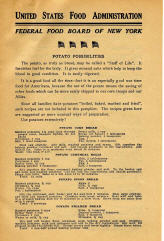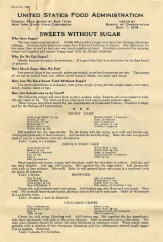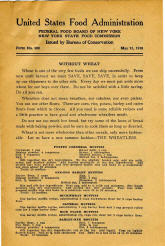
Food Will Win the War: On the Homefront in World War I
Food Will Win the War: On the Homefront in World War I
- Description
- Document
- Discussion Questions
- Extension Activities
- Standards
- Additional Resources
- Contact Us
Description
During World War I, the United States made a great effort to conserve food and other vital materials to help supply the troops and our allies abroad. People were encouraged to follow "Meatless Mondays" and "Wheatless Wednesdays" in an effort to both unite the general public behind the war effort and furnish these essential resources to the allied nations. To facilitate this process, the United States Food Administration was established and led by future President Herbert Hoover. In the New York City area, the local food boards held canning demonstrations for thousands, distributed recipes that replaced wheat and sugar with other ingredients, and told recent immigrants in languages such as Hebrew and Italian why they should be a part of this effort.
In the pamphlets "Without Wheat," "Sweets without Sugar," and "Potato Possibilities," the Federal Food Board of New York provides alternatives to more well-known recipes to help Americans do their part in the war effort.
Documents
Discussion Questions:
- Why did the Federal government try to limit the consumption of wheat, meat, sugars and other types of food?
- What are some of the specific substitutes listed in the recipe books for wheat and sugar? Why are these substitutes suggested?
- How would you describe the Federal government's methods to limit the consumption of these goods?
- Would these tactics influence you to conserve resources? Why or why not?
Extension Activities
- Compare and Contrast to Today: How could the Federal government encourage certain lifestyle changes in our society today? Do you think they would be successful? Why or why not?
- Further Research: During World War I, the Food Administration also created a variety of posters explaining these same messages. Using the National Archives Catalog, research and select 5 posters from the time period that best illustrate the message of conserving resources. Use the Poster Analysis Worksheets to aid in your investigation.
- Debate the Issue: Do you think these recipe books represent propaganda? Why or why not?
- Creative Activity: Have student create a campaign poster, flyer, song, etc to support the campaign to conserve these resources.
- Creative Activity: Have students follow a recipe from the list of wheatless, sugarless, potato instead of one using typical ingredients. How does it compare? What does this tell you about the home front during World War I?
- Creative Activity: Have students create a modern multi-faceted campaign to support reducing certain resources to achieve a significant goal in the current world. For example, a campaign to reduce the use of coal, gasoline and other energy sources to help the environment.
Standards
- National History Standards
- Era 7: The Emergence of Modern America (1890-1930)
- Standard 2C: The student understands the impact at home and abroad of the United States involvement in World War I.
- NY Standards
- SS1.C.3. Study about the major social, political, economic, cultural, and religious developments in New York State and United States history involves learning about the important roles and contributions of individuals and groups.
- NJ Standards
- 6.1.12.A.7.b Evaluate the impact of government policies designed to promote patriotism and to protect national security during times of war (i.e., the Espionage Act and the Sedition Amendment) on individual rights.
- 6.1.12.D.7.b Determine the extent to which propaganda, the media, and special interest groups shaped American public opinion and American foreign policy during World War I.
Additional Resources
- Teaching With Documents: Sow the Seeds of Victory! Posters from the Food Administration During World War I
- World War I Posters, compiled 1917 - 1919
Contact Us
If a teacher finds unique and effective ways to use these documents in their classroom and would like to share them with other teachers, please contact education@nara.gov.


